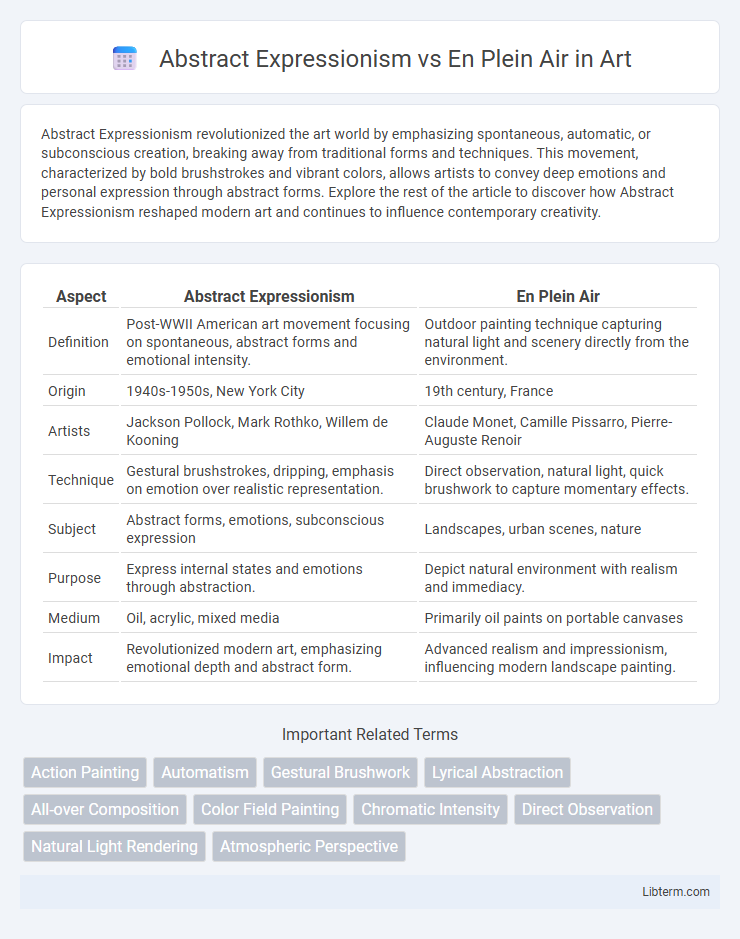Abstract Expressionism revolutionized the art world by emphasizing spontaneous, automatic, or subconscious creation, breaking away from traditional forms and techniques. This movement, characterized by bold brushstrokes and vibrant colors, allows artists to convey deep emotions and personal expression through abstract forms. Explore the rest of the article to discover how Abstract Expressionism reshaped modern art and continues to influence contemporary creativity.
Table of Comparison
| Aspect | Abstract Expressionism | En Plein Air |
|---|---|---|
| Definition | Post-WWII American art movement focusing on spontaneous, abstract forms and emotional intensity. | Outdoor painting technique capturing natural light and scenery directly from the environment. |
| Origin | 1940s-1950s, New York City | 19th century, France |
| Artists | Jackson Pollock, Mark Rothko, Willem de Kooning | Claude Monet, Camille Pissarro, Pierre-Auguste Renoir |
| Technique | Gestural brushstrokes, dripping, emphasis on emotion over realistic representation. | Direct observation, natural light, quick brushwork to capture momentary effects. |
| Subject | Abstract forms, emotions, subconscious expression | Landscapes, urban scenes, nature |
| Purpose | Express internal states and emotions through abstraction. | Depict natural environment with realism and immediacy. |
| Medium | Oil, acrylic, mixed media | Primarily oil paints on portable canvases |
| Impact | Revolutionized modern art, emphasizing emotional depth and abstract form. | Advanced realism and impressionism, influencing modern landscape painting. |
Defining Abstract Expressionism: Origins and Philosophy
Abstract Expressionism emerged in the 1940s in New York, rooted in post-World War II existentialism and the desire for individual emotional expression through non-representational forms. This movement emphasized spontaneous, gestural brushstrokes and a focus on conveying subconscious emotions rather than realistic depictions. In contrast to the outdoor natural light focus of En Plein Air painting, Abstract Expressionism prioritized inner psychological landscapes as the core subject matter.
Understanding En Plein Air: Historical Context and Approach
En Plein Air painting, originating in the 19th century, emphasizes capturing natural light and atmosphere by working outdoors directly from the landscape, reflecting the artist's immediate experience. It contrasts with Abstract Expressionism, which emerged in the mid-20th century with a focus on spontaneous, gestural brushwork and emotional intensity rather than representational accuracy. Understanding En Plein Air requires recognition of its roots in Impressionism and its dedication to realistic portrayal through natural observation.
Key Techniques in Abstract Expressionism
Abstract Expressionism emphasizes spontaneous, gestural brushstrokes and intense color fields, using techniques such as dripping, pouring, and impasto to convey emotional intensity. Artists often employ large canvases to create immersive, dynamic compositions that prioritize inner expression over realistic depiction. This contrasts with the En Plein Air approach, which focuses on capturing natural light and atmosphere through direct observation outdoors.
En Plein Air Methods: Tools and Practices
En Plein Air methods emphasize painting outdoors to capture natural light and atmosphere, utilizing portable easels, lightweight canvases, and a limited palette for quick color mixing. Artists rely on tools like pochade boxes to hold paints and brushes, enabling efficient work directly from the environment. This approach contrasts Abstract Expressionism's studio-based, spontaneous techniques, focusing instead on detailed observation and representation of landscapes.
Core Differences in Artistic Intent
Abstract Expressionism emphasizes spontaneous, subconscious creation aiming to evoke emotional intensity through abstract forms and dynamic brushwork. En Plein Air painting prioritizes capturing natural light, atmosphere, and the immediate environment with direct observation and realistic representation. The core difference lies in Abstract Expressionism's focus on internal expression versus En Plein Air's dedication to external reality.
Influential Artists from Both Movements
Jackson Pollock and Willem de Kooning stand out as influential figures in Abstract Expressionism, known for their dynamic, non-representational techniques and emotional intensity. En Plein Air boasts artists like Claude Monet and Pierre-Auguste Renoir, pioneers of Impressionism who captured natural light and outdoor landscapes with vibrant, spontaneous brushwork. These artists shaped their respective movements by emphasizing different approaches: Abstract Expressionism's internal emotional expression versus En Plein Air's faithful depiction of natural settings.
The Role of Environment and Space
Abstract Expressionism emphasizes the internal emotional landscape through large, dynamic canvases that engage with the studio environment as a controlled, introspective space, allowing spontaneous, gestural brushwork to convey psychological depth. En Plein Air painting prioritizes direct interaction with the natural environment, capturing transient light and atmospheric conditions by working outdoors, which influences the artwork's composition, color palette, and immediacy. The spatial relationship in Abstract Expressionism is subjective and expansive, while En Plein Air focuses on objective observation of a specific landscape, reflecting the physical space in real time.
Emotional Expression vs. Visual Realism
Abstract Expressionism emphasizes emotional expression through spontaneous, gestural brushwork and non-representational forms, evoking intense personal feelings and subconscious states. En Plein Air painting prioritizes visual realism by capturing natural light and atmospheric conditions directly from outdoor observation, resulting in detailed, lifelike landscapes. The former seeks to convey inner emotional experiences, while the latter strives for accurate depiction of the external environment.
Lasting Impact on Modern Art
Abstract Expressionism revolutionized modern art by emphasizing spontaneous, emotional expression and large-scale canvases, influencing generations of contemporary artists and movements such as Neo-Expressionism. En Plein Air painting emphasized direct observation of nature and atmospheric conditions, fostering the development of Impressionism and shaping the trajectory of landscape painting in modern art. Both styles contributed distinctively to modern art's evolution: Abstract Expressionism expanding conceptual and emotional depth, while En Plein Air enhanced realism and the appreciation of natural light.
Choosing Between Abstract Expressionism and En Plein Air
Choosing between Abstract Expressionism and En Plein Air depends on the artist's intent to convey emotion versus capturing natural light and landscape. Abstract Expressionism prioritizes spontaneous, emotive brushwork and non-representational forms, emphasizing inner experience over realism. En Plein Air focuses on direct observation, emphasizing atmospheric effects and natural color variations through outdoor painting techniques.
Abstract Expressionism Infographic

 libterm.com
libterm.com